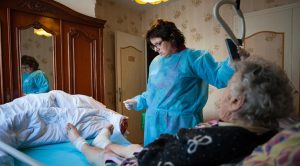Knock Knock, the Nurse Is at the Door
 In a recent Becker’s Healthcare article, a nurse from National Nurses United raised criticisms and concerns about the growth of hospital-at-home programs. As a nurse manager of a hospital-at-home program, I believe it is high time to hear from a nurse with boots-on-the-ground experience in providing acute-level care in the home.
In a recent Becker’s Healthcare article, a nurse from National Nurses United raised criticisms and concerns about the growth of hospital-at-home programs. As a nurse manager of a hospital-at-home program, I believe it is high time to hear from a nurse with boots-on-the-ground experience in providing acute-level care in the home.
Let’s break down the nurse’s misconceptions and look at real-world insights through the lens of my experience at UMass Memorial Health’s Hospital at Home program.
Driving Whole-Person Care: Rewarding to Patients and Providers
The COVID-19 pandemic has fundamentally shifted our healthcare system by highlighting our ability to provide acute-level care safely and effectively to patients in their own homes. It is in this setting that nurses’ critical thinking and assessment skills are so valuable. The nurse has a view of the patient as a whole. Their environment and living conditions are assessed, social determinants of health identified, medication reconciliations completed, and home equipment inspected.
No physician, nurse, case manager, or social worker in the brick-and-mortar hospital can assess the full scope of these important factors affecting a patient’s health and well-being. Unsurprisingly, we have heard some nurses discussing greater job satisfaction in the whole-person approach that hospital-at-home offers. Martha Diaz, RN, a staff member in our program said, “Hospital at Home has brought back the joy to the science and compassion of my nursing profession. There is no better satisfaction to being an RN than knowing I have made a difference in a person’s life.” Providing the RN an opportunity to assess and teach the patient is fundamental to the practice of nursing, and the ability to teach our patients in their own environment is critical in prevention of hospitalizations.
Understanding the Program Structure
Facility-based nurses oftentimes do not understand the robust structure of hospital-at-home programs. In our program, for example, there is a vigorous screening process for each patient under consideration for acute care in the home. We take into consideration factors such as home support, the ability to use technology, and safety concerns for the staff.
Additionally, hospital-at-home nurses are in the home at least twice daily for 1-hour visits, giving undivided attention to a single patient, which is required by CMS under the Acute Hospital Care at Home program. The education of the patient and others involved in care is a priority. This is key to the success of the patient’s recovery and decreasing rates of readmission.
Patients in our program are remotely monitored 24 hours a day. Vital signs integrate into the EMR every 15 minutes, and in-person RN visits validate the data from the wearable devices at a minimum of twice daily. In fact, vital sign data is gathered more frequently than in our facilities, where it is typically collected every 4 to 8 hours per UMass Memorial Acute Care order sets. We also leverage a diverse team of providers, including physicians, RNs, mobile integrated health paramedics, and certified nursing assistants.
Giving Control Back to Patients and Families
Critics of hospital-at-home feel that the “burden of care” is shifted onto the families or the patients. In fact, this is the opposite in our experience. In hospital-at-home programs, patients and families are directly involved in the plan of care. This level of involvement provides patients and families with an understanding of the condition being treated. In the traditional hospital setting, patients and families may have to relinquish some control. Hospital-at-home programs empower patients and family members at every stage of the care journey.
Working Toward the Goal of Improved Quality
Our hospital-at-home quality metrics speaks for themselves. In comparison to brick-and-mortar hospital benchmarks, UMass Memorial’s Hospital at Home program offers improved outcomes for our patients (see table below). In our program, patients have fewer falls, fewer discharges to skilled nursing facility units, and lower readmissions to the hospital within a 30-day period after a hospital-at-home admission. Additionally, hospital-acquired infections are significantly reduced in comparison to a brick-and-mortar admission.
Hospital at Home Is the Innovation Patients Need
As medical technology and treatment have advanced, there has been an innovation lag in the improvement of care for patients in traditional hospital settings. Innovation is not reaching patients in many facility-based hospitals like it is in hospital-at-home models. On top of this, the patient population has changed, with higher rates of comorbidities that complicate the medical journey. Yet, traditional hospitals still rush to discharge either because of capacity issues or to make room for more critically ill patients.
That all changes with hospital-at-home, where innovation and whole-person care are at the center of the model. The benefits of shifting patients to the home are plentiful. In terms of increasing hospital capacity through hospital-at-home programs, emergency department wait times decrease, rates of readmissions decline, and patient satisfaction increases (based on increased HCAHPS scores and lower readmission rates).
I encourage my fellow nurses to look through a new lens. Hospital at home fundamentally changed my view of how care should be delivered. Many of our patients want it, and they deserve the option to choose their preferred site of care.
(Deidre Rolli, BS, RN, is the nurse manager for UMass Memorial Health Hospital at Home.)
(This story originally appeared in Medpage Today.)




